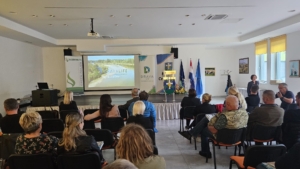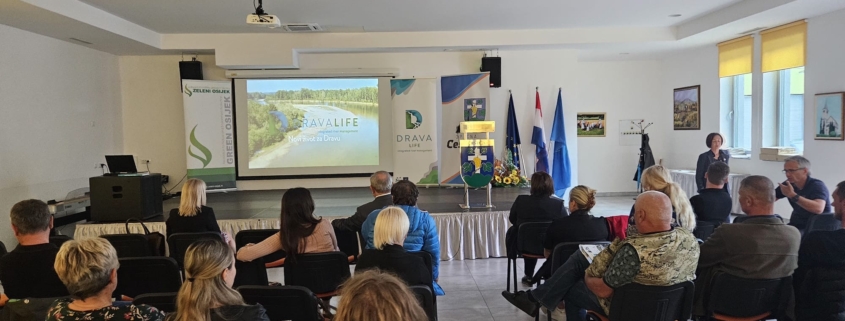Commencement of Restoration Works for the Drava River Ecosystem in Varaždin County

Općina Cestica, 12.9.2024.
Municipality of Cestica, September 12, 2024 – Restoration work on the Drava River ecosystem continues at the Otok Virje (C1) site in Varaždin County as part of the “DRAVA LIFE – Integrated River Management” project. The aim is to restore a 1.3 km-long side channel and partially remove the riverbank reinforcement, allowing water to flow into the channel and fostering the creation of new habitats for birds. This work will enhance the river’s natural dynamics, contribute to the protection of endangered species, and improve flood safety in populated areas.
Currently, the right side channel of the Drava River, “Otok Virje (C.1),” is not connected to the river from the upstream side; instead, water enters it from the downstream side. The area is mostly overgrown with dense vegetation, with larger stretches of forest along the course of the Drava River. To improve water flow, it is essential to remove vegetation around the bridge and the side channel and utilize the excavated material to build access roads. These measures will benefit numerous endangered habitats and species in the Natura 2000 areas and enhance flood protection in populated areas along the Drava River, while also increasing the recreational value of the area for the local community.
DRAVA LIFE – the largest river restoration project in Croatia – is entering its final phase, laying the foundation for future projects and international cooperation

“Through the implementation of this unique project, which exemplifies the collaboration between water management and nature conservation institutions and NGOs, we are restoring key natural features of the Drava ecosystem by reopening and creating new side channels, removing and adapting riverbank reinforcements, and preserving floodplains and natural steep riverbanks,” said Igor Tošić, project manager at Croatian Waters.
To ensure protection for future generations, the DRAVA LIFE project area has become part of the world’s first Five-Country UNESCO Biosphere Reserve Mura-Drava-Danube (MDD), known as the “European Amazon.” This project encompasses regions in Austria, Slovenia, Croatia, Hungary, and Serbia, integrating the Drava River into the global network of the world’s most renowned natural areas.
“We are proud that the DRAVA LIFE project, the first of its kind in Croatia and the region, has laid the groundwork for future projects and collaboration on the restoration of the Mura-Drava-Danube river ecosystem, one of the most important in Europe,” emphasized Arno Mohl from WWF Austria.

Silvija Zagorec, Deputy Prefect of Varaždin County, emphasized that the Drava River enters Croatia precisely in this county, where there is a strong awareness of the importance of its conservation.
“The Drava flows through eight of our municipalities and one city, shaping and defining a significant part of our county. The river has been protected since 2011 and is the largest protected area in our county, with international significance as it is also under UNESCO protection. This commitment requires us to provide long-term care and protection for this river. In our county, the Drava River is home to as many as 200 bird species, and studies have shown that it boasts the highest diversity of fish species in Croatia. We must preserve this wealth,” said Silvija Zagorec.
The Public Institution “Nature of Varaždin County” is continuously engaged in the protection and conservation of the areas along the Drava River. In recent years, through various projects, they have conducted research on fauna, including dragonflies, beetles, otters, fish, and amphibians. Notably, they have published informative booklets available to all interested citizens. In the Drava area of Varaždin County, they have established six DRAVA LIFE informational and educational points, as well as an educational playground for children in the Drava Park Forest in Varaždin.
Additionally, they continue to implement activities for the reintroduction of the sand martin (Myricaria germanica), a species that is nearly extinct today but was once common along the river’s gravel banks. They are also working on habitat maintenance for rare bird species, which includes improving steep banks for nesting sand martins and maintaining islands for nesting little ringed plovers in the reservoir of the Varaždin Hydroelectric Plant.


 Nikolina Stjepanović
Nikolina Stjepanović
